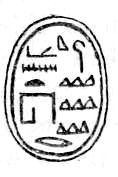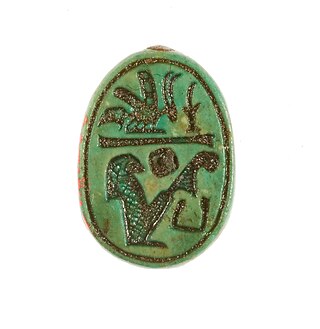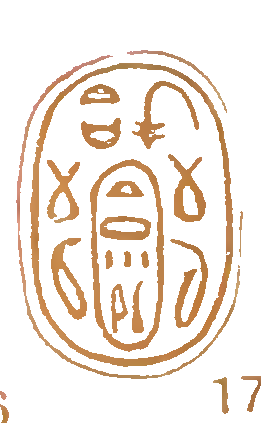
Merneferre Ay was an ancient Egyptian pharaoh of the mid 13th Dynasty. The longest reigning pharaoh of the 13th Dynasty, he ruled a likely fragmented Egypt for over 23 years in the early to mid 17th century BC. A pyramidion bearing his name shows that he possibly completed a pyramid, probably located in the necropolis of Memphis.

Amenhotep III, also known as Amenhotep the Magnificent or Amenhotep the Great and Hellenized as Amenophis III, was the ninth pharaoh of the Eighteenth Dynasty. According to different authors, he ruled Egypt from June 1386 to 1349 BC, or from June 1388 BC to December 1351 BC/1350 BC, after his father Thutmose IV died. Amenhotep was Thutmose's son by a minor wife, Mutemwiya.

Sobekneferu or Neferusobek was a pharaoh of ancient Egypt and the last ruler of the Twelfth Dynasty of the Middle Kingdom. She ascended to the throne following the death of Amenemhat IV, possibly her brother or husband, though their relationship is unproven. Instead, she asserted legitimacy through her father Amenemhat III. Her reign lasted 3 years, 10 months, and 24 days, according to the Turin King List.

Ancient Egyptian art refers to art produced in ancient Egypt between the 6th millennium BC and the 4th century AD, spanning from Prehistoric Egypt until the Christianization of Roman Egypt. It includes paintings, sculptures, drawings on papyrus, faience, jewelry, ivories, architecture, and other art media. It was a conservative tradition whose style changed very little over time. Much of the surviving examples comes from tombs and monuments, giving insight into the ancient Egyptian afterlife beliefs.

The Thirteenth Dynasty of ancient Egypt is often combined with Dynasties XI, XII and XIV under the group title Middle Kingdom. Some writers separate it from these dynasties and join it to Dynasties XIV through XVII as part of the Second Intermediate Period. Dynasty XIII lasted from approximately 1803 BC until approximately 1649 BC, i.e. for 154 years.

Khasekhemre Neferhotep I was an Egyptian pharaoh of the mid Thirteenth Dynasty ruling in the second half of the 18th century BC during a time referred to as the late Middle Kingdom or early Second Intermediate Period, depending on the scholar. One of the best attested rulers of the 13th Dynasty, Neferhotep I reigned for 11 years.

Anat-her may have been the first ruler of the Sixteenth Dynasty of Egypt, reigning over some part of Lower Egypt during the Second Intermediate Period as a vassal of the Hyksos kings of the 15th Dynasty. This is contested however, with the Egyptologists Kim Ryholt and Darrel Baker believing that 'Anat-Har was a Canaanite chieftain contemporary with the powerful 12th Dynasty. Others such as Nicholas Geoffrey Lempriere Hammond contend that he was a prince of the 15th Dynasty. 'Anat-Har's name means "Anat is content" and refers to the Semitic goddess Anat, showing that he was of Canaanite descent.

Semqen was a Hyksos ruler of Lower Egypt during the Second Intermediate Period in the mid-17th century BC. According to Jürgen von Beckerath he was the third king of the 16th Dynasty and a vassal of the Hyksos kings of the 15th Dynasty. This opinion was shared by William C. Hayes and Wolfgang Helck but recently rejected by Kim Ryholt. In his 1997 study of the Second Intermediate Period, Ryholt argues that the kings of the 16th Dynasty ruled an independent Theban realm c. 1650–1580 BC. Consequently, Ryholt sees Semqen as an early Hyksos king of the 15th Dynasty, perhaps its first ruler. This analysis has convinced some Egyptologists, such as Darrell Baker and Janine Bourriau, but not others including Stephen Quirke.

Khamudi was the last Hyksos ruler of the Fifteenth Dynasty of Egypt. Khamudi came to power in 1534 BC or 1541 BC, ruling the northern portion of Egypt from his capital Avaris. His ultimate defeat at the hands of Ahmose I, after a short reign, marks the end of the Second Intermediate Period.

Maaibre Sheshi was a ruler of areas of Egypt during the Second Intermediate Period. The dynasty, chronological position, duration and extent of his reign are uncertain and subject to ongoing debate. The difficulty of identification is mirrored by problems in determining events from the end of the Middle Kingdom to the arrival of the Hyksos in Egypt. Nonetheless, Sheshi is, in terms of the number of artifacts attributed to him, the best-attested king of the period spanning the end of the Middle Kingdom and the Second Intermediate period; roughly from c. 1800 BC until 1550 BC. Hundreds of scaraboid seals bearing his name have been found throughout the Levant, Egypt, Nubia, and as far away as Carthage, where some were still in use 1,500 years after his death.

Sobekhotep III was an Egyptian king of the mid Thirteenth Dynasty of Egypt who reigned three to four years.

Menkare was an ancient Egyptian pharaoh, the first or second ruler of the Eighth Dynasty. Menkare probably reigned a short time at the transition between the Old Kingdom period and the First Intermediate Period, in the early 22nd century BC. The rapid succession of brief reigns at the time suggests times of hardship, possibly related to a widespread aridification of the Middle East, known as the 4.2 kiloyear event. As a pharaoh of the Eighth Dynasty, according to Manetho, Menkare's seat of power would have been Memphis.

Neferkare Khendu was an ancient Egyptian pharaoh of the Eighth Dynasty during the early First Intermediate Period. According to the Egyptologists Kim Ryholt, Jürgen von Beckerath and Darrell Baker he was the sixth king of the Eighth Dynasty.

Sehetepibre Sewesekhtawy was an Egyptian pharaoh of the 13th Dynasty during the early Second Intermediate Period, possibly the fifth or tenth king of the Dynasty.

Scarabs are beetle-shaped amulets and impression seals which were widely popular throughout ancient Egypt. They still survive in large numbers today, and are popular among collectors of ancient artifacts. Through their inscriptions and typology, they prove to be an important source of information for archaeologists and historians of the ancient world, and represent a significant body of ancient Egyptian art.
Satsobek was an Ancient Egyptian queen with the titles Great Royal Wife and the one united with the white crown. She is so far only known from one scarab seal in a private collection. The scarab is datable on stylistical grounds to the Thirteenth Dynasty. Her husband remains unknown. Her name is written Sasobek, without the female t ending in Sat (daughter). This might be a simple mistake or short writing, but it is also possible that she used a male name Sasobek -. Male names for women are common in this period.

Neferkasokar was an Ancient Egyptian king (pharaoh) who may have ruled in Egypt during the 2nd Dynasty. Very little is known about him, since no contemporary records about him have been found. Rather his name has been found in later sources.

Merkheperre was an Egyptian pharaoh of the late 13th Dynasty of Egypt during the Second Intermediate Period reigning some time between 1663 BC and 1649 BC. As such, Merkheperre would have reigned either over Upper Egypt from Thebes or over Middle and Upper Egypt from Memphis. At the time, the Eastern Nile Delta was under the domination of the 14th Dynasty.

Sekhaenre Yakbim or Yakbmu was a ruler during the Second Intermediate Period of Egypt. Although his dynastic and temporal collocation is disputed, Danish Egyptologist Kim Ryholt believes that he likely was the founder of the Levantine-blooded Fourteenth Dynasty, while in older literature he was mainly considered a member of the Sixteenth Dynasty.

Tati was an ancient Egyptian queen. She is the only queen known by name from the Fourteenth Dynasty. Her position is unknown.




















